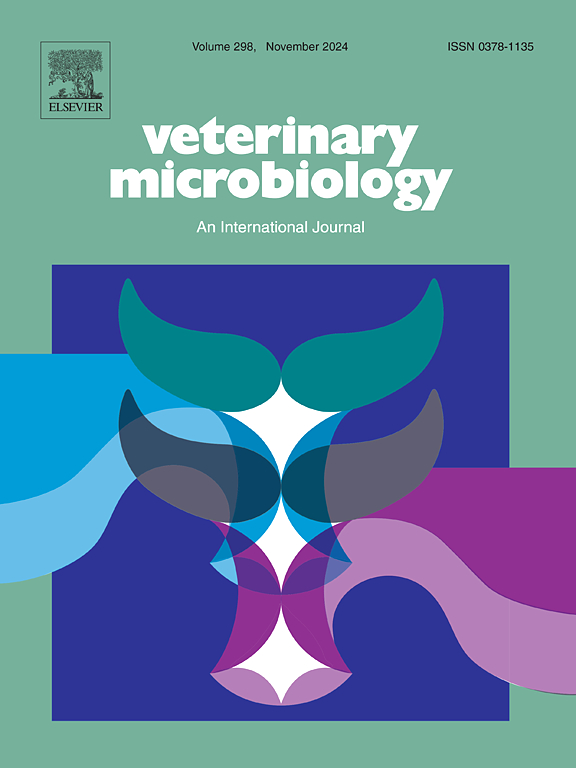从大肠埃希菌供体向鸡体内海德堡沙门氏菌的四环素抗性基因转移受供体遗传背景的影响
IF 2.4
2区 农林科学
Q3 MICROBIOLOGY
引用次数: 0
摘要
鸡盲肠是细菌的丰富来源,其中包括人畜共患病病原体,如肠炎沙门氏菌。微生物群包括携带抗菌素耐药性基因的菌株/菌种,菌种间耐药性决定因子的水平转移可能会增加对公共卫生和养殖系统的风险。这些抗菌药耐药性供体的可能来源--从母鸡垂直传播给后代的蛋壳携带细菌,或孵化和饲养雏鸡的鸡舍环境--还很少被探索。在这项研究中,我们利用海德堡肠炎沙门氏菌血清来评估在不同环境中饲养的蛋鸡(使用灭菌或非灭菌鸡蛋组合,放置在灭菌隔离室或非灭菌室内)是否会从周围细菌(尤其是大肠杆菌)中获得可转移的四环素耐药基因。用抗生素敏感的海德堡沙门氏菌株 SH2813nalR 和在不同时间点从雏鸡盲肠中回收的沙门氏菌对两天大的雏鸡进行挑战,以检验体内四环素耐药性的获得情况。体内实验中从鸟类体内分离出的耐四环素的大肠杆菌被用来测试体外四环素耐药基因从大肠杆菌转移到沙门氏菌的情况。尽管沙门氏菌 SH2813nalR 在口服沙门氏菌后定植于 2 日龄的雏鸡体内,但并未发现耐四环素的沙门氏菌转座子,这与之前的观察结果相同。体外实验也得出了类似的结果。尽管回收的大肠杆菌中存在多种质粒,但体外和体内均未发现转结合体,我们讨论了几种可能的假说。对于不同质粒类型,抑制/促进抗菌药耐药性转移到沙门氏菌的因素需要进一步探讨。本文章由计算机程序翻译,如有差异,请以英文原文为准。
Tetracycline resistance gene transfer from Escherichia coli donors to Salmonella Heidelberg in chickens is impacted by the genetic context of donors
Chicken ceca are a rich source of bacteria, including zoonotic pathogens such as Salmonella enterica. The microbiota includes strains/species carrying antimicrobial resistance genes and horizontal transfer of resistance determinants between species may increase the risk to public health and farming systems. Possible sources of these antimicrobial resistance donors – the eggshell carrying bacteria from the hen vertically transmitted to the offspring, or the barn environment where chicks are hatched and raised – has been little explored. In this study, we used Salmonella enterica serovar Heidelberg to evaluate if layer chicks raised in different environments (using combinations of sterilized or non-sterile eggs placed in sterilized isolation chambers or non-sterile rooms) acquired transferable tetracycline resistance genes from surrounding bacteria, especially Escherichia coli. Two-day old chicks were challenged with an antibiotic-susceptible S. Heidelberg strain SH2813nalR and Salmonella recovered from the cecum of birds at different timepoints to test the in vivo acquisition of tetracycline resistance. Tetracycline-resistant E. coli isolates recovered from birds from the in vivo experiment were used to test the in vitro transfer of tetracycline resistance genes from E. coli to Salmonella. Even though Salmonella SH2813nalR colonized the 2-day old chicks after oral challenge, tetracycline-resistant Salmonella transconjugants were not recovered, as previously observed. In vitro experiments provided similar results. We discuss several hypotheses that might explain the absence of transconjugants in vitro and in vivo, despite the presence of diverse plasmids in the recovered E. coli. The factors that can inhibit/promote antimicrobial resistance transfers to Salmonella for different plasmid types need further exploration.
求助全文
通过发布文献求助,成功后即可免费获取论文全文。
去求助
来源期刊

Veterinary microbiology
农林科学-兽医学
CiteScore
5.90
自引率
6.10%
发文量
221
审稿时长
52 days
期刊介绍:
Veterinary Microbiology is concerned with microbial (bacterial, fungal, viral) diseases of domesticated vertebrate animals (livestock, companion animals, fur-bearing animals, game, poultry, fish) that supply food, other useful products or companionship. In addition, Microbial diseases of wild animals living in captivity, or as members of the feral fauna will also be considered if the infections are of interest because of their interrelation with humans (zoonoses) and/or domestic animals. Studies of antimicrobial resistance are also included, provided that the results represent a substantial advance in knowledge. Authors are strongly encouraged to read - prior to submission - the Editorials (''Scope or cope'' and ''Scope or cope II'') published previously in the journal. The Editors reserve the right to suggest submission to another journal for those papers which they feel would be more appropriate for consideration by that journal.
Original research papers of high quality and novelty on aspects of control, host response, molecular biology, pathogenesis, prevention, and treatment of microbial diseases of animals are published. Papers dealing primarily with immunology, epidemiology, molecular biology and antiviral or microbial agents will only be considered if they demonstrate a clear impact on a disease. Papers focusing solely on diagnostic techniques (such as another PCR protocol or ELISA) will not be published - focus should be on a microorganism and not on a particular technique. Papers only reporting microbial sequences, transcriptomics data, or proteomics data will not be considered unless the results represent a substantial advance in knowledge.
Drug trial papers will be considered if they have general application or significance. Papers on the identification of microorganisms will also be considered, but detailed taxonomic studies do not fall within the scope of the journal. Case reports will not be published, unless they have general application or contain novel aspects. Papers of geographically limited interest, which repeat what had been established elsewhere will not be considered. The readership of the journal is global.
 求助内容:
求助内容: 应助结果提醒方式:
应助结果提醒方式:


